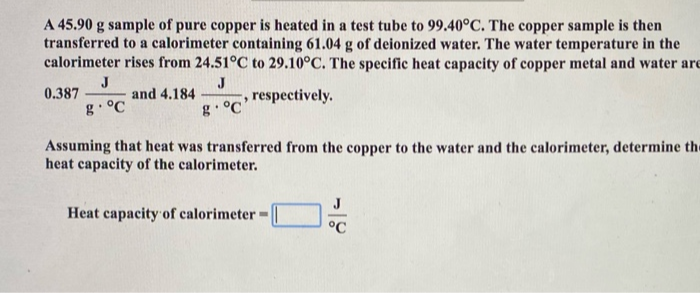A 45.90 g sample of pure copper is heated in a test tube to 99.40°C. The copper sample is then transferred to a calorimeter containing 61.04 g of deionized water. The water temperature in the calorimeter rises from 24.51°C to 29.10°C. The specific heat capacity of copper metal and water are J and 4.184 J respectively. g• °C 0.387 g• °C Assuming that heat was transferred from the copper to the water and the calorimeter, determine th heat capacity of the calorimeter. Heat capacity of calorimeter =
A 45.90 g sample of pure copper is heated in a test tube to 99.40°C. The copper sample is then transferred to a calorimeter containing 61.04 g of deionized water. The water temperature in the calorimeter rises from 24.51°C to 29.10°C. The specific heat capacity of copper metal and water are J and 4.184 J respectively. g• °C 0.387 g• °C Assuming that heat was transferred from the copper to the water and the calorimeter, determine th heat capacity of the calorimeter. Heat capacity of calorimeter =
Chemistry: An Atoms First Approach
2nd Edition
ISBN:9781305079243
Author:Steven S. Zumdahl, Susan A. Zumdahl
Publisher:Steven S. Zumdahl, Susan A. Zumdahl
Chapter7: Chemical Energy
Section: Chapter Questions
Problem 109AE: A sample of nickel is heated to 99.8C and placed in a coffee-cup calorimeter containing 150.0 g...
Related questions
Question

Transcribed Image Text:A 45.90 g sample of pure copper is heated in a test tube to 99.40°C. The copper sample is then
transferred to a calorimeter containing 61.04 g of deionized water. The water temperature in the
calorimeter rises from 24.51°C to 29.10°C. The specific heat capacity of copper metal and water are
J
and 4.184
J
respectively.
g• °C
0.387
g• °C
Assuming that heat was transferred from the copper to the water and the calorimeter, determine th
heat capacity of the calorimeter.
Heat capacity of calorimeter =
Expert Solution
This question has been solved!
Explore an expertly crafted, step-by-step solution for a thorough understanding of key concepts.
This is a popular solution!
Trending now
This is a popular solution!
Step by step
Solved in 7 steps

Knowledge Booster
Learn more about
Need a deep-dive on the concept behind this application? Look no further. Learn more about this topic, chemistry and related others by exploring similar questions and additional content below.Recommended textbooks for you

Chemistry: An Atoms First Approach
Chemistry
ISBN:
9781305079243
Author:
Steven S. Zumdahl, Susan A. Zumdahl
Publisher:
Cengage Learning

Chemistry for Engineering Students
Chemistry
ISBN:
9781337398909
Author:
Lawrence S. Brown, Tom Holme
Publisher:
Cengage Learning

General Chemistry - Standalone book (MindTap Cour…
Chemistry
ISBN:
9781305580343
Author:
Steven D. Gammon, Ebbing, Darrell Ebbing, Steven D., Darrell; Gammon, Darrell Ebbing; Steven D. Gammon, Darrell D.; Gammon, Ebbing; Steven D. Gammon; Darrell
Publisher:
Cengage Learning

Chemistry: An Atoms First Approach
Chemistry
ISBN:
9781305079243
Author:
Steven S. Zumdahl, Susan A. Zumdahl
Publisher:
Cengage Learning

Chemistry for Engineering Students
Chemistry
ISBN:
9781337398909
Author:
Lawrence S. Brown, Tom Holme
Publisher:
Cengage Learning

General Chemistry - Standalone book (MindTap Cour…
Chemistry
ISBN:
9781305580343
Author:
Steven D. Gammon, Ebbing, Darrell Ebbing, Steven D., Darrell; Gammon, Darrell Ebbing; Steven D. Gammon, Darrell D.; Gammon, Ebbing; Steven D. Gammon; Darrell
Publisher:
Cengage Learning

Principles of Modern Chemistry
Chemistry
ISBN:
9781305079113
Author:
David W. Oxtoby, H. Pat Gillis, Laurie J. Butler
Publisher:
Cengage Learning

Chemistry
Chemistry
ISBN:
9781305957404
Author:
Steven S. Zumdahl, Susan A. Zumdahl, Donald J. DeCoste
Publisher:
Cengage Learning

Chemistry by OpenStax (2015-05-04)
Chemistry
ISBN:
9781938168390
Author:
Klaus Theopold, Richard H Langley, Paul Flowers, William R. Robinson, Mark Blaser
Publisher:
OpenStax